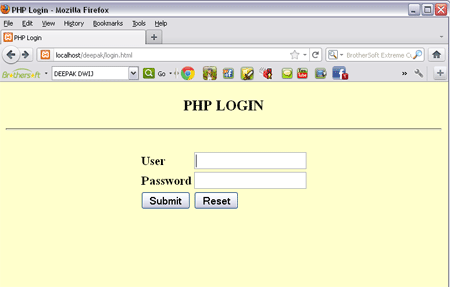Related code: How to Create Secure Login Page in PHP/MySQL. Yesterday I posted a tutorial on how to create a registration page using PHP/MySQL.To make some follow up with my registration page tutorial, I decided to create another tutorial on how to create a login page using PHP/MySQL. How to create a login page using PHP. Source Code: Thank you for watching. Watch this video to learn how to create a phpinfo.php page. Create a phpinfo.php page To create a phpinfo file, open a plain text file, add the following lines, and save. How to Create a Web Page Template Using PHP Includes. These instructions will guide you through the process of setting up a template Web page that is constructed with PHP include files. We will use a very simple example Web page to. Related code: How to Create Secure Login Page in PHP/MySQL. Yesterday I posted a tutorial on how to create a registration page using PHP/MySQL.To make some follow up with my registration page tutorial, I decided to create another tutorial on how to create a login page using PHP/MySQL. PHP 5 File Create/Write Previous Next In this chapter we will teach you how to create and write to a file on the server. PHP Create File - fopen(). Create a new PHP web page called register_success.php, in the root directory of the application. This version of How to Create a Secure Login Script in PHP and.
In this chapter we will teach you how to create and write to a file on the server.

PHP Create File - fopen()

The fopen() function is also used to create a file. Maybe a little confusing, but in PHP, a file is created using the same function used to open files.
If you use fopen() on a file that does not exist, it will create it, given that the file is opened for writing (w) or appending (a).
The example below creates a new file called 'testfile.txt'. The file will be created in the same directory where the PHP code resides:
Basic Php Page
Example
PHP File Permissions
If you are having errors when trying to get this code to run, check that you have granted your PHP file access to write information to the hard drive.
PHP Write to File - fwrite()
The fwrite() function is used to write to a file.
The first parameter of fwrite() contains the name of the file to write to and the second parameter is the string to be written.
The example below writes a couple of names into a new file called 'newfile.txt':
How To Create A Login Page In Php
Example

$myfile = fopen('newfile.txt', 'w') or die('Unable to open file!');
$txt = 'John Doen';
fwrite($myfile, $txt);
$txt = 'Jane Doen';
fwrite($myfile, $txt);
fclose($myfile);
?>
Notice that we wrote to the file 'newfile.txt' twice. Each time we wrote to the file we sent the string $txt that first contained 'John Doe' and second contained 'Jane Doe'. After we finished writing, we closed the file using the fclose() function.
If we open the 'newfile.txt' file it would look like this:
PHP Overwriting
Now that 'newfile.txt' contains some data we can show what happens when we open an existing file for writing. All the existing data will be ERASED and we start with an empty file.
In the example below we open our existing file 'newfile.txt', and write some new data into it:
How To Create A Page On Youtube
Example
$myfile = fopen('newfile.txt', 'w') or die('Unable to open file!');
$txt = 'Mickey Mousen';
fwrite($myfile, $txt);
$txt = 'Minnie Mousen';
fwrite($myfile, $txt);
fclose($myfile);
?>
If we now open the 'newfile.txt' file, both John and Jane have vanished, and only the data we just wrote is present:
Complete PHP Filesystem Reference
For a complete reference of filesystem functions, go to our complete PHP Filesystem Reference.